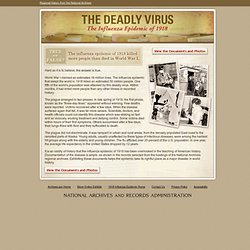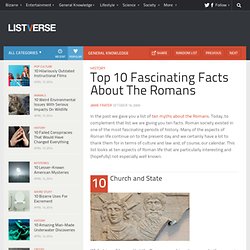

The Influenza Epidemic of 1918. Hard as it is to believe, the answer is true.

World War I claimed an estimated 16 million lives. The influenza epidemic that swept the world in 1918 killed an estimated 50 million people. One fifth of the world's population was attacked by this deadly virus. Within months, it had killed more people than any other illness in recorded history. International Institute of Social History, Amsterdam, Netherlands.
History. Medieval Society. Ancient Rome. Top 10 Fascinating Facts About The Romans. History In the past we gave you a list of ten myths about the Romans.

Today, to complement that list we are giving you ten facts. Roman society existed in one of the most fascinating periods of history. Many of the aspects of Roman life continue on to the present day and we certainly have a lot to thank them for in terms of culture and law and, of course, our calendar. This list looks at ten aspects of Roman life that are particularly interesting and (hopefully) not especially well known. While it is well known that the Romans worshipped many gods, there was, in fact, an official state god.
Just like today, Romans lived in a variety of different dwellings depending on class. The closest thing Romans had to underwear was a subligaculumIt could come either in the form of a pair of shorts, or in the form of a simple loincloth wrapped around the lower body. Education was very important to the Ancient Romans. “We were invited to take our seats. Pecunia non olet means “money does not smell”. DengeDenge Online Magazine. Metal detecting pensioner finds Wales' oldest coin. A detecting enthusiast has unearthed a thought to be one of the oldest ever found in . Retired butcher Roy Page, 69, of Coedpoeth, found the detailed 2,000-year-old coin on a farm near St Asaph when he went on a search there with the Mold-based Historical Search Society. handed the tiny silver coin to the Portable Antiquities Scheme, who identified it as dating from the second century BC.
It is believed to have been brought over some time after the Roman invasion of in 43 AD, or during earlier visits in the first century BC. Roy, who has been for five years, said: "The person who held the coin was probably a Roman. "When he told me I nearly fainted, I was over the moon. "It shows how far the Romans came into this country. "It is living history. "When you look at a map of where have been found in there have not been many found around St Asaph. " The coin depicts two horses being driven by a man on a chariot. said: "I flipped the soil back and it was there, only six inches down. Roman Soldiers’ Tattoo History. Home Tattoo Blog Tattoo Gallery Tattoo Buzz Tattoo Books Tattoo Ideas & Designs > Tattoo History > Roman Soldiers’ Tattoo History --> Ancient Tattoo Art: Egyptian Tattoos Dreamcatcher Tattoos Do You Approve of Skinhead Tattoos?

UV Tattoo Art: For and Against. Year 1.
History of Iran: The Cyrus the Great Cylinder. The Cyrus the Great CylinderEdited by: Shapour Ghasemi The Cyrus the Great Cylinder is the first charter of right of nations in the world.

It is a baked-clay cyliner in Akkadian language with cuneiform script. This cylinder was excavated in 1879 by the Assyro-British archaeologist Hormuzd Rassam in the foundations of the Esagila (the Marduk temple of Babylon) and is kept today in the British Museum in London. On October 12 (Julian calendar; October 7 by the Gregorian calendar) 539 BC, Achaemanid army without any conflict entered the city of Babylon. Cyrus the Great himself, on October 29, entered the city, assuming the titles of "king of Babylon, king of Sumer and Akkad, king of the four corners of the world". There were three main premises in the decrees of the Cyrus Cylinder: the political formulization of racial, linguistic, and religious equality, slaves and all deported peoples were to be allowed to return to home; and all destroyed temples were to be restored.[1] Notes: Foot Notes:
Knowledge and Power - Knowledge and Power in the Neo-Assyrian Empire.
HistoryNet. A Chronology of US Historical Documents.